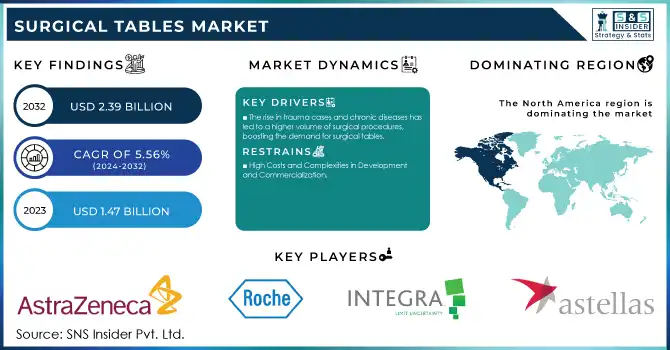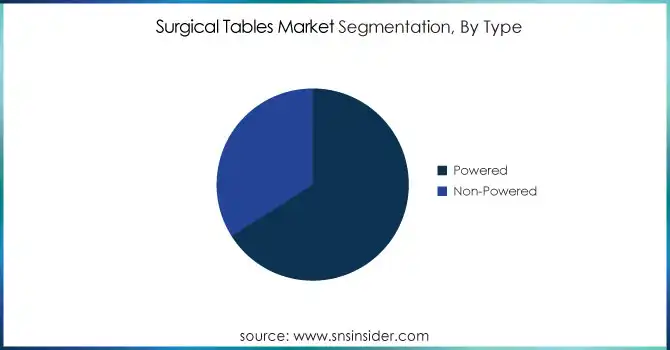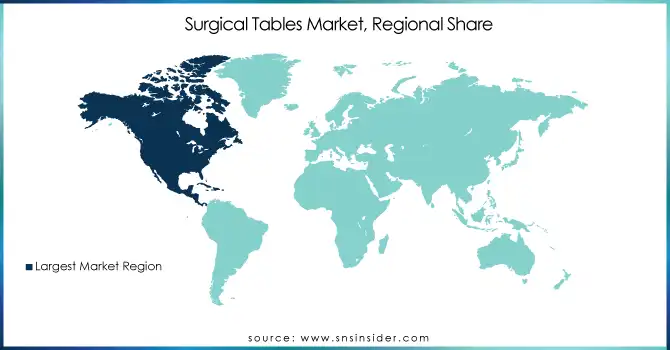Surgical Tables Market Size & Trends:
The Surgical Tables Market size was estimated at USD 1.47 billion in 2023 and is expected to reach USD 2.39 billion by 2032 at a CAGR of 5.56% over the forecast period 2024-2032.

Get More Information on Surgical Tables Market - Request Sample Report
The global surgical tables market is growing at a high rate owing to various factors such as the growing prevalence of chronic diseases, the rising geriatric population, and technological advancements in surgical procedures. As per the World Health Organization (WHO) report, by 2050, the number of people aged 60 years and older will surpass 2 billion, up from 900 million in 2015. An increasing geriatric population is anticipated to drive the surgical volumes, which in turn, is projected to spur the demand for surgical tables. Moreover, the market growth is driven by various government initiatives in order to enhance the healthcare infrastructure. As an example, the United States Department of Health and Human Services estimated that national health spending is expected to increase at an average annual rate of 5.4% for 2019-28 and reach $6.2 trillion by 2028.
The current trend of preference to minimal invasive survive further boosting the demand for dedicated surgical tables having better imaging as well as positioning for the desired outcome. Moreover, the U.S. Food and Drug Administration (FDA) has been on a spree in advancing new surgical devices and techniques, which further impels the market growth. Considering the worldwide uptick in healthcare systems aiming to achieve improved patient outcomes and shorter hospital stays, the increase of advanced surgical tables is likely to proliferate at a steady growth rate boosting this market as the vital domain of the healthcare equipment market. In addition, new trends such as the growing geriatric population, as well as the increasing number of ambulatory surgical centers as well as the growing preference for hybrid operating rooms are driving the market. In the coming years, the continued technological advancements in the design and functionality of surgical tables along with these factors are likely to add further momentum to the growth of the market.
Market Dynamics
Drivers
-
The rise in trauma cases and chronic diseases has led to a higher volume of surgical procedures, boosting the demand for surgical tables.
-
Innovations such as modular designs and enhanced safety features in surgical tables are attracting healthcare facilities to upgrade their equipment.
Technological advancements are playing a substantial role in the growth of the surgical tables market by improving functionality, safety, and adaptability to contemporary surgical requirements. In addition, modern advancements resulted in surgical tables with enhanced motion, imaging and more, which has transformed how surgeons perform surgical procedures. For example, robotic surgery systems have begun to be a significant development in operating suites. These systems often include a camera arm and mechanical arms with surgical instruments attached, controlled by the surgeon from a console near the operating table. The setup allows for more precise work and minimally invasive procedures, improving outcomes for patients.
It has also enabled hybrid OTs that combine traditional surgical capabilities with advanced imaging technologies and require OTSs that can meet both surgical and interventional needs. They often have radiolucent tabletops and are compatible with imaging devices, allowing for ease of movement between procedure types. These advancements ensure high efficiency and effective surgical procedures in return steering the demand for advanced surgical tables to accommodate such innovations. The evolution process of surgical techniques will boost the growing demand for surgical tables with multi-functional and technological integration, thereby further driving the market growth.
Restraints
-
Advanced surgical tables with modern features can be expensive, potentially limiting their adoption, especially in budget-constrained healthcare settings.
-
The complexity of new surgical table technologies necessitates additional training for medical staff, which can be a barrier to rapid implementation.
The high cost of advanced surgical tables is a key restraint in the surgical table market. Available in various markets, surgical tables have upgraded technology with several unique features that cater to the diverse needs of surgical procedures, such as modular and motorized surgical tables. Although these characteristics maximize functionality and patient outcomes, they come at a high cost of manufacturing and procurement.
Spending these amounts is often difficult for healthcare facilities, especially in developing or low-budget regions, where the costs are difficult to justify with their limited budgets. Many smaller hospitals and clinics will use lower-end or reconditioned machines, which could also affect the efficiency and safety of these procedures. Additionally, the cost barrier may prevent healthcare providers from replacing their old equipment, causing a delay in upgrades that could improve operational efficiency. This translates into the fact that the extremely expensive surgical table continues to be a very high barrier anywhere on the globe, especially in parts with low health service funding and or lower per capita healthcare expenditures.
Surgical Tables Market Segmentation Overview
By Product
In 2023, general surgical tables had the highest revenue share of 31% in the market. The ability of general surgical tables to be used in a wide range of medical procedures is among the reasons for this dominance. General surgical tables are versatile equipment in most health settings as they can hold patients intended for different types of surgery, from simple OPD-based procedures to complex in-patient surgery. The relatively high number of general surgeries has a substantial impact on the high market share of this segment. An estimated 48 million surgical and nonsurgical procedures were performed in U.S. hospitals in 2019, according to the Centers for Disease Control and Prevention (CDC). Many of these were general surgeries, and many could be done on typical surgical tables.
In addition, initiatives taken by the government to improve access to healthcare indirectly increased the demand for general surgical tables. For example, the U.S. Department of Health and Human Services has stated that the Affordable Care Act has enabled 20 million adults to secure health insurance coverage, which may contribute to the number of surgical procedures one can access. The procurement of essential medical equipment, including the general surgical tables, is increasing due to the effort made by the government in strengthening the healthcare infrastructure in the developing countries. Growth in the adoption of general surgical tables in India is expected to be driven by an increase in expenditure of the Indian government by the National Health Mission towards improvement in healthcare facilities in rural areas. Moreover, general surgical tables are relatively inexpensive as compared to the specialized tables, which is a major factor driving general surgical tables share in the North American market as the healthcare providers are also focusing on adopting these cost-effective types of tables for their financial viability.
By Type
In 2023, the powered segment held the largest revenue share of 66%. The powered surgical tables market has a significant share, attributed to the several benefits offered by powered surgical tables, such as high accuracy, better positioning of patients, and reduced physical effort by healthcare professionals on the patients. Powered surgical tables are designed which enable the stability of adjustment over time which is very important for complex surgeries that require frequent repositioning. The increasing adoption of minimally invasive surgeries that require accurate patient positioning is also fueling the demand for powered tables. The American Society of Plastic Surgeons reports that in 2020, 15.6 million cosmetic procedures performed in the U.S. were minimally invasive, which indicates a growing trend toward these types of procedures.
The demand for powered surgical tables is also supported by regulatory aspects and government guidelines focusing on the safety of patients. As an example, in the United States, OSHA provides guidelines for safe patient handling that are easier to comply with when powered tables are specified. The European Union Medical Device Regulation (EU MDR) has been a driving factor in the European market for surgical tables, causing hospitals to look to powered surgical tables to comply with the new standards. In addition to this, the modernization of healthcare facilities initiated by the government indirectly provides an up thrust to the powered surgical tables market. In order to cite one, the UK Government has announced the allocation of a £3.7 billion fund for the construction of 40 new hospitals to be completed by 2030 which is anticipated to create a demand for advanced medical equipment, including powered surgical tables.

By material
The metal segment held the largest revenue share of 50% in 2023 Metal is probably the most common material in the market for surgical tables due to its strength, stability, and low price. These are good corrosion-resistant, cleanable, and sterilizable tables suited for the stringent hygiene requirements of healthcare environments, especially as hospital's sanitary goods. Metal tables are strong enough to hold heavy loads and are designed for frequent use in busy surgical environments. Another reason for metal surgical tables being the go-to choice is the strict regulations set by the government regarding materials used for medical devices. Metal surgical tables also conform to the strict guidelines set by the U.S. Food and Drug Administration (FDA) on materials used in medical devices.
The Medical Device Regulation (MDR) 2017/745 in Europe is unrivaled in demanding the highest standards for safety and performance, a level of assurance that metal constructions are ideally positioned to meet, particularly in surgical tables. Moreover, reforms undertaken by governments to upgrade healthcare infrastructure in developing countries have resulted in much more durable and cost-efficient procurement of medical equipment, such as metal surgical tables. India's National Health Mission, for example, emphasized fortifying public health centers, resulting in enhanced adoption of metal surgical tables in public hospitals. WHO guidance on the decontamination and reprocessing of medical devices for healthcare facilities also promotes the use of sites that can endure stringent cleaning methods, again promoting the use of metal surgical tables
By End Use
In 2023, the hospital segment dominated the majority of the revenue share, with a share of 37%. Several factors contribute to this major market share such as a high number of surgical procedures performed in hospitals, better medical infrastructure in hospitals, and the willingness of hospitals to spend money on complex surgical instruments. In 2019, U.S. hospitals had about 33.7 million admissions, many of which required surgery, according to the American Hospital Association. Hospitals are usually the primary venue of complex surgeries that need specialized surgical tables, making them hold the largest share of the surgical table product market. Government efforts to upgrade hospital infrastructure have also significantly contributed to boosting demand for surgical tables in this segment. As one example, the U.S. Hill-Burton Act passed in 1946, is still applied to drive efforts to develop and modernize hospitals. Most recently the CARES Act, established in 2020, allocated about $100 billion in relief funds for hospitals and other healthcare providers, perhaps allowing the purchase of necessary surgical tables and other medical equipment.
The National Health Service (NHS) in the UK reports that there were 17.1 million hospital admissions in 2019-2020, indicating the large burden of patients in the hospital setting. Efforts continue within the NHS to reduce waiting times for elective surgeries by investing in surgical facilities and equipment. The growing initiatives by governments to strengthen tertiary care, particularly in developing countries have further driven this segment toward growth. India is one such country where the government has introduced several initiatives, such as Pradhan Mantri Swasthya Suraksha Yojana (PMSSY) to strengthen the infrastructure through the upgradation of the existing institutions and setting up of new All India Institutes of Medical Sciences (AIIMS) which in turn is leading to an increase in demand for advanced surgical equipment in hospitals.
Regional Analysis
The largest share of the global surgical tables market in 2023 was held by North America. The region is expected by far account for the largest share owing to robust healthcare infrastructure, high healthcare spending, and early adoption of advanced medical technologies. Such huge expense on medication also funds every other component of clinical infrastructure, as clinical amenities require advanced surgical hardware and apparatus, including a surgical desk. Major market players and an increased emphasis on R&D in this region further support a major share of the market.
However, the Asia Pacific region is expected to grow at the fastest CAGR during the forecast period. Such a rise is driven by factors such as exponential growth in healthcare infrastructure, rising healthcare expenditure, and a larger number of patients. The enhancement and establishment of healthcare facilities and the use of advanced healthcare machinery are being promoted by the governments of China, India, and other countries. According to the above factors, for example, China's Healthy China 2030 research plan aims to popularize basic medical and health services for all citizens by 2030, which is expected to increase the demand for surgical tables. As a part of surgical procedures, the growing prevalence of chronic diseases and the geriatric population in the Asia Pacific region is also responsible for the rising demand for surgical tables in this region. The United Nations Economic and Social Commission for Asia and the Pacific also estimates that the number of older persons living in this region will more than double, from 535 million in 2015 to around 1.3 billion by 2050 suggesting a growing potential demand for surgery.

Get Customized Report as per Your Business Requirement - Request For Customized Report
Recent developments
-
In July 2023, Hospital Products Australia revealed Mindray HyBase V9 Operating Table, another leap forward in surgical table technology. With smart safety features like anti-collision sensors and automatic locking mechanisms, the table provides a safe work environment during procedures and therefore, helps minimize accidents.
-
In April 2024, Getinge Launches a Novel Corin OR Table and Ezea Surgical Light at the Association of periOperative Registered Nurses (AORN) March Conference in Nashville, TN, March 10-12, 2024. These advanced technologies aim to enhance operational efficiency in surgical environments and provide maximum patient and healthcare professional safety.
Key Players
Key Service Providers/Manufacturers
-
Hill-Rom Holdings, Inc. (TruSystem 3000 Surgical Table, TruSystem 7000dV Surgical Table)
-
Steris Plc. (STERIS 4085 General Surgical Table, STERIS CMAX 3 Surgical Table)
-
Stryker Corporation (Stryker SM104 Power-PRO XT, Stryker 1088 HD Video System)
-
Getinge AB (Maquet Alphamaquet 1150, Maquet Magnus Operating Table)
-
Shenzhen Mindray Bio-Medical Electronics Co., Ltd. (HyBase 6100 Surgical Table, HyBase 3000 Operating Table)
-
Mizuho OSI (ProAxis Spinal Surgery Table, Trios Surgical Table System)
-
Skytron LLC (Skytron 3603 UltraSlide, Skytron 6701 Hercules)
-
Alvo Medical (ALVO Serenada, ALVO Sonata)
-
Allengers Medical Systems Ltd. (Allengers OT Table 4001, Allengers OT Table 4008)
-
Trumpf Medical (HillRom Services, Inc.) (TruSystem 7000dV, TruSystem 7500)
-
Merivaara Corp. (Merivaara Promerix, Merivaara Practico)
-
Schaerer Medical USA Inc. (Schaerer Axis 350, Schaerer Arcus 501)
-
NUVO Inc. (Nuvo V1000 Surgical Table, Nuvo V8000 Surgical Table)
-
Eschmann Holdings Ltd. (Eschmann T20, Eschmann MR200)
-
AGA Sanitätsartikel GmbH (AGA-OP-Table 100, AGA-JUS 2000)
-
Stille AB (Stille Medstone5, Stille Medstone3)
-
Lojer Oy (Lojer Scandia, Lojer Manuthera 242)
-
Staan Bio-Med Engineering Private Limited (Staan 3008 Deluxe, Staan 4008 Super Deluxe)
-
OPT SurgiSystems (OPT 40/1, OPT 30/1)
-
UFSK-International OSYS GmbH (UFSK-OSYS 500 XLE, UFSK-OSYS 600 XLE)
| Report Attributes | Details |
| Market Size in 2023 | USD 1.47 Billion |
| Market Size by 2032 | USD 2.39 Billion |
| CAGR | CAGR of 5.56% From 2024 to 2032 |
| Base Year | 2023 |
| Forecast Period | 2024-2032 |
| Historical Data | 2020-2022 |
| Report Scope & Coverage | Market Size, Segments Analysis, Competitive Landscape, Regional Analysis, DROC & SWOT Analysis, Forecast Outlook |
| Key Segments | • By Type (Powered, Non-powered) • By Product Type (General Surgical Tables, Specialty Surgical Tables {Bariatric Surgical Tables, Laparoscopic Surgical Tables, Neurosurgical Surgical Tables, Orthopedic Surgical Tables}, Radiolucent Surgical Tables, Pediatric Surgical Tables) • By Material (Metal, Composite) • By End-use (Hospital, Ambulatory Surgery Centers, Specialty Clinics & Trauma Centers) |
| Regional Analysis/Coverage | North America (US, Canada, Mexico), Europe (Eastern Europe [Poland, Romania, Hungary, Turkey, Rest of Eastern Europe] Western Europe] Germany, France, UK, Italy, Spain, Netherlands, Switzerland, Austria, Rest of Western Europe]), Asia Pacific (China, India, Japan, South Korea, Vietnam, Singapore, Australia, Rest of Asia Pacific), Middle East & Africa (Middle East [UAE, Egypt, Saudi Arabia, Qatar, Rest of Middle East], Africa [Nigeria, South Africa, Rest of Africa], Latin America (Brazil, Argentina, Colombia, Rest of Latin America) |
| Company Profiles | Hill-Rom Holdings, Inc., Steris Plc., Stryker Corporation, Getinge AB, Shenzhen Mindray Bio-Medical Electronics Co., Ltd., Mizuho OSI, Skytron LLC, Alvo Medical, Allengers Medical Systems Ltd., Trumpf Medical, Merivaara Corp., Schaerer Medical USA Inc., NUVO Inc., Eschmann Holdings Ltd., AGA Sanitätsartikel GmbH, Stille AB, Lojer Oy, Staan Bio-Med Engineering Private Limited, OPT SurgiSystems, UFSK-International OSYS GmbH |
| Key Drivers | • The rise in trauma cases and chronic diseases has led to a higher volume of surgical procedures, boosting the demand for surgical tables. • Innovations such as modular designs and enhanced safety features in surgical tables are attracting healthcare facilities to upgrade their equipment. |
| Restraints | • Advanced surgical tables with modern features can be expensive, potentially limiting their adoption, especially in budget-constrained healthcare settings. • The complexity of new surgical table technologies necessitates additional training for medical staff, which can be a barrier to rapid implementation. |

